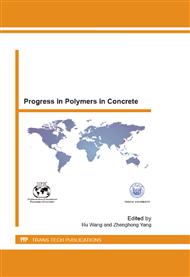p.57
p.68
p.77
p.84
p.88
p.94
p.100
p.107
p.112
The Preparation and Characterization of Redispersible Polymer Powder with Core-Shell Structure
Abstract:
Acrylate polymer emulsion was synthesized by semi-continuous seeded emulsion polymerization with methacrylic acid (MAA) as the hydrophilic shell monomer. The redispersible polymer powder was prepared by spray drying method. The effects of the amount of MAA, styrene (St) stoichiometry equivalents to methyl methacrylate, and two kinds of spray drying methods on size distribution of the redispersible polymer powder were further systematically investigated. The Malvern laser particle size analyzer, transition electron microscopy (TEM), scanning electron microscopy (SEM) and differential scanning calorimeter were employed to characterize the redispersible polymer powder. Results showed that the redispersible polymer powder obtained by pneumatic spray drying with excellent re-dispersibility could be synthesized at 10 % of MAA, 50 % of St stoichiometry equivalents. The final copolymer emulsion with “perfect” core-shell morphology was approved by TEM, and the comparable film forming ability of the redispersible polymer powder with the original emulsion was observed by SEM, which could form a dense and smooth membrane.
Info:
Periodical:
Pages:
88-93
Citation:
Online since:
April 2013
Authors:
Price:
Сopyright:
© 2013 Trans Tech Publications Ltd. All Rights Reserved
Share:
Citation:


